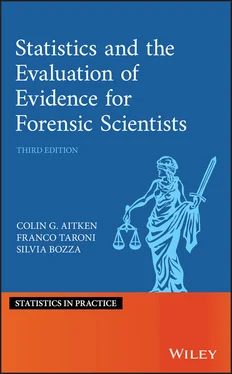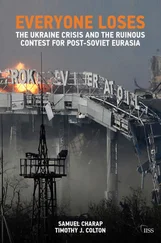Franco Taroni - Statistics and the Evaluation of Evidence for Forensic Scientists
Здесь есть возможность читать онлайн «Franco Taroni - Statistics and the Evaluation of Evidence for Forensic Scientists» — ознакомительный отрывок электронной книги совершенно бесплатно, а после прочтения отрывка купить полную версию. В некоторых случаях можно слушать аудио, скачать через торрент в формате fb2 и присутствует краткое содержание. Жанр: unrecognised, на английском языке. Описание произведения, (предисловие) а так же отзывы посетителей доступны на портале библиотеки ЛибКат.
- Название:Statistics and the Evaluation of Evidence for Forensic Scientists
- Автор:
- Жанр:
- Год:неизвестен
- ISBN:нет данных
- Рейтинг книги:3 / 5. Голосов: 1
-
Избранное:Добавить в избранное
- Отзывы:
-
Ваша оценка:
Statistics and the Evaluation of Evidence for Forensic Scientists: краткое содержание, описание и аннотация
Предлагаем к чтению аннотацию, описание, краткое содержание или предисловие (зависит от того, что написал сам автор книги «Statistics and the Evaluation of Evidence for Forensic Scientists»). Если вы не нашли необходимую информацию о книге — напишите в комментариях, мы постараемся отыскать её.
he leading resource in the statistical evaluation and interpretation of forensic evidence
The third edition of
is fully updated to provide the latest research and developments in the use of statistical techniques to evaluate and interpret evidence. Courts are increasingly aware of the importance of proper evidence assessment when there is an element of uncertainty. Because of the increasing availability of data, the role of statistical and probabilistic reasoning is gaining a higher profile in criminal cases. That’s why lawyers, forensic scientists, graduate students, and researchers will find this book an essential resource, one which explores how forensic evidence can be evaluated and interpreted statistically. It’s written as an accessible source of information for all those with an interest in the evaluation and interpretation of forensic scientific evidence.
Discusses the entire chain of reasoning–from evidence pre-assessment to court presentation; Includes material for the understanding of evidence interpretation for single and multiple trace evidence; Provides real examples and data for improved understanding. Since the first edition of this book was published in 1995, this respected series has remained a leading resource in the statistical evaluation of forensic evidence. It shares knowledge from authors in the fields of statistics and forensic science who are international experts in the area of evidence evaluation and interpretation. This book helps people to deal with uncertainty related to scientific evidence and propositions. It introduces a method of reasoning that shows how to update beliefs coherently and to act rationally. In this edition, readers can find new information on the topics of elicitation, subjective probabilities, decision analysis, and cognitive bias, all discussed in a Bayesian framework.

 that takes the value 1 (i.e. success) if the analysed unit is positive and 0 (i.e. failure) otherwise. This is a generic type of case that applies well to many situations, such as surveys or, more generally, sampling procedures conducted to infer the proportion of individuals or items in a population who share a given property or possess certain characteristics (e.g. that of being counterfeit). Suppose now that
that takes the value 1 (i.e. success) if the analysed unit is positive and 0 (i.e. failure) otherwise. This is a generic type of case that applies well to many situations, such as surveys or, more generally, sampling procedures conducted to infer the proportion of individuals or items in a population who share a given property or possess certain characteristics (e.g. that of being counterfeit). Suppose now that  units are analysed, so that there are
units are analysed, so that there are  possible outcomes. The forensic scientist should be able to assign a probability to each of the 1024 possible outcomes. At this point, if it was reasonable to assume that only the observed values
possible outcomes. The forensic scientist should be able to assign a probability to each of the 1024 possible outcomes. At this point, if it was reasonable to assume that only the observed values  matter and not the order in which they appear, the forensic scientist would have a sensibly simplified task. In fact, the total number of probability assignments would reduce from 1024 to 11, since it is assumed that all sequences are assigned the same probability if they have the same number of 1's, (i.e. successes). This is possible if it is thought that all the items are indistinguishable in the sense that it does not matter which particular item produced a success (e.g. a positive response) or a failure (e.g. a negative response). Stated otherwise, this means that one's probability assignment is invariant under changes in the order of successes and failures. If the outcomes were permuted in any way, assigned probabilities would be unchanged. For a coin‐tossing experiment, Lindley (2014) has expressed this as follows:
matter and not the order in which they appear, the forensic scientist would have a sensibly simplified task. In fact, the total number of probability assignments would reduce from 1024 to 11, since it is assumed that all sequences are assigned the same probability if they have the same number of 1's, (i.e. successes). This is possible if it is thought that all the items are indistinguishable in the sense that it does not matter which particular item produced a success (e.g. a positive response) or a failure (e.g. a negative response). Stated otherwise, this means that one's probability assignment is invariant under changes in the order of successes and failures. If the outcomes were permuted in any way, assigned probabilities would be unchanged. For a coin‐tossing experiment, Lindley (2014) has expressed this as follows: denote a forecaster's prediction of rain on the following day. Let
denote a forecaster's prediction of rain on the following day. Let  be the forecaster's actual subjective probability of rain for that day. Let an arbitrary function
be the forecaster's actual subjective probability of rain for that day. Let an arbitrary function  be the forecaster's score if rain occurs and let another arbitrary function
be the forecaster's score if rain occurs and let another arbitrary function  be their score if rain does not occur. With an assumption that the forecaster wishes to maximise their score, assume that
be their score if rain does not occur. With an assumption that the forecaster wishes to maximise their score, assume that  is an increasing function of
is an increasing function of  and
and  is a decreasing function of
is a decreasing function of  . For a prediction of
. For a prediction of  and an actual subjective probability of
and an actual subjective probability of  , the expected score of the forecaster is
, the expected score of the forecaster is
 . A strictly proper scoring rule is one for which
. A strictly proper scoring rule is one for which  is the only value of
is the only value of  that maximises ( 1.3).
that maximises ( 1.3). of their actual subjective probability
of their actual subjective probability  of rain on that day. The expected Brier score is then
of rain on that day. The expected Brier score is then











